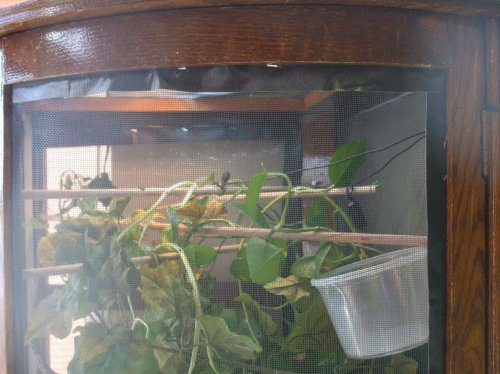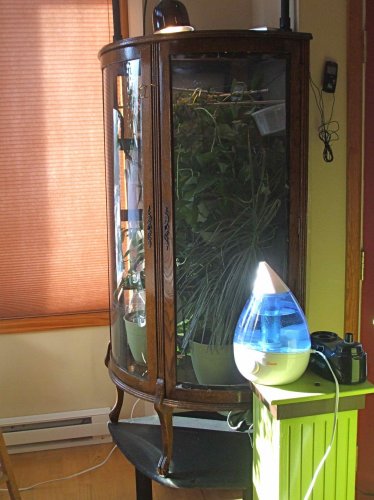GrogStudio
New Member
Wherever my guy is-- in the cage, free roaming on his ficus or on the screened patio-- he always seems to choose a favorite basking spot and just hangs there, even when it gets hot and he starts gaping.
If he's in his cage, I turn down the basking light (I keep the temp between 85 and 90-- usually about 87) and he stops gaping. But he rarely leaves his preferred basking spot except to do a little patrolling or eating and then back to his spot. He does sometimes go to his sleeping spot early, though. He has no signs of a RI-- no mucus or labored breathing or lethargy.
I just built him his third cage and put lots of dowels at slightly different levels so he has even more options for basking but he hasn't used the different levels much yet. The cage is full of live plants and is quite tall so he has lots of temperature options beyond the dowels.
Do I really need to keep my eye on the temp or will he eventually move on his own if he gets super hot?
*Your Chameleon– Male veiled just over a year old and in my home about 8 months.
Handling– He loves coming out. I usually let him hang on ficus or screened patio (in summer) several times/week
Feeding – He gets pickier as he get older. Mostly hornworms, superworms and crickets these days. We gave up and sold our dubia colony. Has also eaten butterworms and phoenix worms and soldier flies (as well as wax and mealworms) but not lately. He has eaten red pepper, yams, carrots, apple, melon, strawberries, blueberries, and raspberries but his current favorite is grapes. Won't eat greens (except his plants) so I gutload mostly with greens (e.g., dandelion, collards) and bug burger. He mostly cup feeds.
Supplements – Reptivite calcium daily, reptivite mulitvitamin and flukers calcium with D3 2x/ month.
Watering – I mist 2-6 times daily depending on cage humidity and I set up drippers for about an hour 1-2x/ day. Rarely see him drink but has always had white urates.
Fecal Description – Black w/ white urate. If I see any hint of yellow I soak his veggies super well and increase mistings.
History - I had no intention of getting a chameleon but he was in a way-too-small glass cage (about 8 inches square) at a petshop and he convinced me to try to do better by him. (I know purchasing in petshop has complex ethics).
Cage Info:
Cage Type – Just moved him to a converted corner china cabinet, about 46 high x 38 wide at widest, but tapers to corner.
Lighting – 100 watt heat bulb on a dimmer and 5.0 UVB tube by reptisun.
Temperature – Ambient temp around 70 but there are lots of cool spots if he wants as the cage if FULL of live plants. Basking about 87. Lowest overnight 62 (higher in summer). Have digital probes for temp and humidity.
Humidity – The swamp cooler was great in the summer but humidity is a challenge in the winter. He has shower curtain liners around most of cage, and I have a fogger and 2 room humidifiers to help.
Plants – Pothos, shefflera and dracena.
Placement – Cage is in my studio so I keep an eye on temp and humidity all day and he sees me regularly.
Location - Colorado
If he's in his cage, I turn down the basking light (I keep the temp between 85 and 90-- usually about 87) and he stops gaping. But he rarely leaves his preferred basking spot except to do a little patrolling or eating and then back to his spot. He does sometimes go to his sleeping spot early, though. He has no signs of a RI-- no mucus or labored breathing or lethargy.
I just built him his third cage and put lots of dowels at slightly different levels so he has even more options for basking but he hasn't used the different levels much yet. The cage is full of live plants and is quite tall so he has lots of temperature options beyond the dowels.
Do I really need to keep my eye on the temp or will he eventually move on his own if he gets super hot?
*Your Chameleon– Male veiled just over a year old and in my home about 8 months.
Handling– He loves coming out. I usually let him hang on ficus or screened patio (in summer) several times/week
Feeding – He gets pickier as he get older. Mostly hornworms, superworms and crickets these days. We gave up and sold our dubia colony. Has also eaten butterworms and phoenix worms and soldier flies (as well as wax and mealworms) but not lately. He has eaten red pepper, yams, carrots, apple, melon, strawberries, blueberries, and raspberries but his current favorite is grapes. Won't eat greens (except his plants) so I gutload mostly with greens (e.g., dandelion, collards) and bug burger. He mostly cup feeds.
Supplements – Reptivite calcium daily, reptivite mulitvitamin and flukers calcium with D3 2x/ month.
Watering – I mist 2-6 times daily depending on cage humidity and I set up drippers for about an hour 1-2x/ day. Rarely see him drink but has always had white urates.
Fecal Description – Black w/ white urate. If I see any hint of yellow I soak his veggies super well and increase mistings.
History - I had no intention of getting a chameleon but he was in a way-too-small glass cage (about 8 inches square) at a petshop and he convinced me to try to do better by him. (I know purchasing in petshop has complex ethics).
Cage Info:
Cage Type – Just moved him to a converted corner china cabinet, about 46 high x 38 wide at widest, but tapers to corner.
Lighting – 100 watt heat bulb on a dimmer and 5.0 UVB tube by reptisun.
Temperature – Ambient temp around 70 but there are lots of cool spots if he wants as the cage if FULL of live plants. Basking about 87. Lowest overnight 62 (higher in summer). Have digital probes for temp and humidity.
Humidity – The swamp cooler was great in the summer but humidity is a challenge in the winter. He has shower curtain liners around most of cage, and I have a fogger and 2 room humidifiers to help.
Plants – Pothos, shefflera and dracena.
Placement – Cage is in my studio so I keep an eye on temp and humidity all day and he sees me regularly.
Location - Colorado





